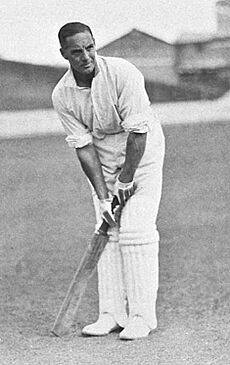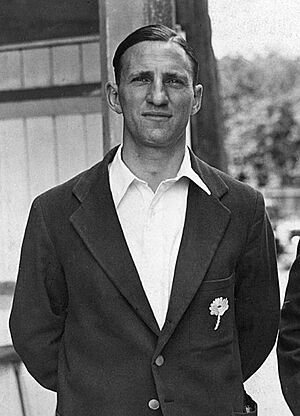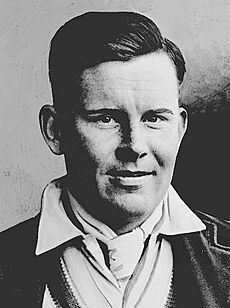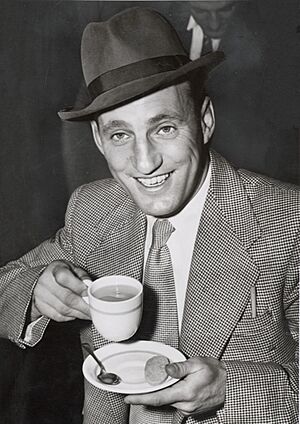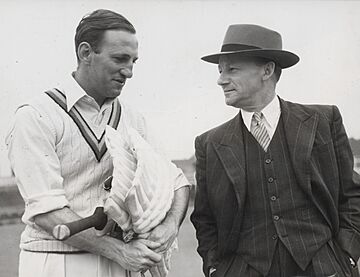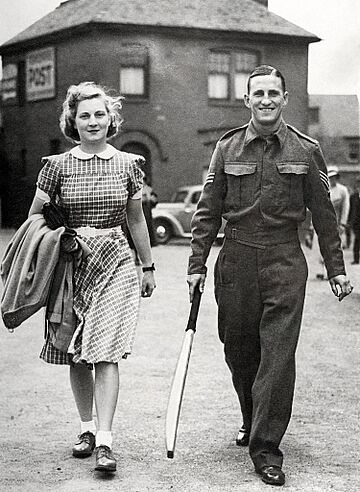Len Hutton facts for kids

Hutton in about 1938
|
||||||||||||||||||||||||||||||||||||||||
| Personal information | ||||||||||||||||||||||||||||||||||||||||
|---|---|---|---|---|---|---|---|---|---|---|---|---|---|---|---|---|---|---|---|---|---|---|---|---|---|---|---|---|---|---|---|---|---|---|---|---|---|---|---|---|
| Full name |
Leonard Hutton
|
|||||||||||||||||||||||||||||||||||||||
| Born | 23 June 1916 Fulneck, Pudsey, Yorkshire, England |
|||||||||||||||||||||||||||||||||||||||
| Died | 6 September 1990 (aged 74) Kingston-upon-Thames, London, England |
|||||||||||||||||||||||||||||||||||||||
| Batting | Right-handed | |||||||||||||||||||||||||||||||||||||||
| Bowling | Right-arm leg break | |||||||||||||||||||||||||||||||||||||||
| Role | Opening batsman | |||||||||||||||||||||||||||||||||||||||
| Relations | Richard Hutton (son) John Hutton (son) |
|||||||||||||||||||||||||||||||||||||||
| International information | ||||||||||||||||||||||||||||||||||||||||
| National side | ||||||||||||||||||||||||||||||||||||||||
| Test debut (cap 294) | 26 June 1937 v New Zealand | |||||||||||||||||||||||||||||||||||||||
| Last Test | 25 March 1955 v New Zealand | |||||||||||||||||||||||||||||||||||||||
| Domestic team information | ||||||||||||||||||||||||||||||||||||||||
| Years | Team | |||||||||||||||||||||||||||||||||||||||
| 1934–1955 | Yorkshire | |||||||||||||||||||||||||||||||||||||||
| 1938–1960 | Marylebone Cricket Club | |||||||||||||||||||||||||||||||||||||||
| Career statistics | ||||||||||||||||||||||||||||||||||||||||
|
||||||||||||||||||||||||||||||||||||||||
|
Source: CricInfo, 14 August 2007
|
||||||||||||||||||||||||||||||||||||||||
Sir Leonard Hutton (born June 23, 1916 – died September 6, 1990) was an amazing English cricket player. He was an opening batsman for Yorkshire County Cricket Club from 1934 to 1955. He also played for the England team in 79 Test matches between 1937 and 1955.
Many experts called him "one of the greatest batsmen in the history of cricket". In 1938, he set a huge record. He scored 364 runs in a Test match against Australia. This was the highest score ever in a Test match at the time. It was also only his sixth Test game! This record stood for almost 20 years. Even today, it's still England's highest Test score.
After World War II, Hutton was super important for England's batting. In 1952, he made history. He became the first professional cricketer in the 1900s to be England's captain in Test matches. The very next year, under his leadership, England won the Ashes. This was a huge deal, as they hadn't won it in 19 years!
Hutton was seen as a future star from a young age. He started playing for Yorkshire in 1934. By 1937, he was playing for England. When the war stopped cricket in 1939, he was already one of the best batsmen in the world. During the war, he got a serious arm injury. This forced him to change how he batted. But he still became one of England's top players. He was known for his careful and strong batting style. He focused on good defence. Hutton is still considered one of the best Test cricketers ever.
He captained the England Test team from 1952 to 1955. Sometimes, his cautious style made people call him too negative. He didn't always feel comfortable as captain. He felt that the amateur players who ran English cricket didn't fully trust him. As captain, he won 8 out of 23 Tests and lost 4. The rest were draws. The job was very demanding. Hutton retired from regular cricket in 1955. He was made a Sir in 1956 for his contributions to cricket. After retiring, he worked as a Test selector, journalist, and broadcaster. He also worked for an engineering company. In 1990, he became president of Yorkshire County Cricket Club. He passed away a few months later, at age 74.
Contents
Early Life and Cricket Beginnings
Len Hutton was born on June 23, 1916. He grew up in Fulneck, a small community in Pudsey, England. He was the youngest of five children. His family loved cricket, and Len quickly fell in love with the sport too. He played and read about cricket all the time.
He practiced in his school playground and at the Pudsey St Lawrence Cricket Club. By age 12, he was playing for the club's second team. By 1929, he was on the first team. Local people encouraged him to meet Herbert Sutcliffe. Sutcliffe was a famous Yorkshire and England cricketer who lived nearby. Hutton got coaching from Sutcliffe in his garden. Sutcliffe was very impressed with young Len. He told the Yorkshire team that Hutton was a great talent.
In 1930, Hutton went to Yorkshire's practice ground. Coaches there, like George Hirst, thought his batting was already amazing. Bill Bowes, a Yorkshire bowler, also helped him. Hutton decided to become a professional cricketer. He also learned a trade, working with his father in a building firm. In 1930, he watched the Australian legend Don Bradman score 334 runs in a Test match. Eight years later, Hutton would break that record himself!
Becoming a Cricket Star
Joining Yorkshire's Team
By 1933, Hutton was a regular opening batsman for Pudsey St Lawrence. He learned a lot from his batting partner, Edgar Oldroyd. Hutton became known as a promising player. He even scored 108 runs in a big cup match. Yorkshire saw him as a future partner for Sutcliffe. He was also a good leg spin bowler.
In 1933, Hutton played for the Yorkshire Second Eleven. He scored 699 runs that season, averaging 69.90. Yorkshire gave him mentors like Cyril Turner, Hedley Verity, and Bowes.
Hutton made his first-class debut for Yorkshire in 1934. He was only 17, the youngest Yorkshire player in 45 years. He scored 50 runs in his second match. He played regularly that season. He scored his first century, 196 runs, against Worcestershire. He was the youngest Yorkshire batsman to do this. He ended the season with 863 runs.
In 1935, Hutton had nose surgery. This made him miss some games and feel unwell. But he still scored a century against Middlesex. He helped Yorkshire win the County Championship. In 1936, he scored over 1,000 runs for the first time. He was given his "county cap" in July.
Some critics thought Hutton was too careful in his early years. They said he didn't play attacking shots enough. But Yorkshire wasn't worried. His strong defensive style helped him later on. Sutcliffe praised him highly, calling him "a marvel". This praise put a lot of pressure on Hutton.
England Test Debut
In 1937, Hutton started the season with many high scores. He scored 271 against Derbyshire and 153 against Leicestershire. Because of this, he was chosen to play for England against New Zealand.
He made his Test debut on June 26 at Lord's Cricket Ground. He didn't score many runs in that game. But he kept his place by scoring more centuries for Yorkshire. On July 24, he scored his first Test hundred. He batted for three and a half hours to score exactly 100 runs. He also shared a great partnership with Charlie Barnett.
In 1937, Hutton scored 2,888 runs in total. This was more than double his previous best. He scored ten centuries. He also had his best bowling performance, taking six wickets for 76 runs. For his amazing year, he was named one of Wisden's Cricketers of the Year.
Setting a Test Record Score
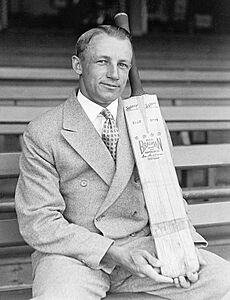
In 1938, Hutton was chosen for the Ashes series against Australia. He scored 100 runs in his first Ashes game. England scored a huge total of 658 runs. Hutton didn't do well in the next two Tests. Then, he broke his finger and missed a month of cricket. But he was back for the final Test.
The last Test started on August 20, 1938, at The Oval. The pitch was very good for batting. Hutton and his Yorkshire teammate, Maurice Leyland, scored 347 runs together on the first day. Hutton was on 160 runs. On the second day, Hutton reached 300 runs. He was aiming to break Donald Bradman's record of 334 runs. Bradman's score was seen as the most important record.
On the third day, Hutton passed Bradman's score. He scored 364 runs before being caught out. His innings lasted over 13 hours! He faced 847 balls. This was the longest innings in first-class cricket at the time. It was only his sixth Test match. Hutton's score was the highest individual score in a Test until 1958. It is still the 6th highest in Tests and the most by an English player. England ended up scoring 903 runs, a record team total. England won the match easily.
People praised Hutton's focus and endurance. His slow scoring was understood because the match had no time limit. Hutton later said that the fame he got was hard to deal with. People expected him to score huge runs every time he batted.
Cricket After the War
First Tour to Australia
County cricket started again in 1946. Hutton's arm injury still bothered him. He couldn't rotate his wrists fully. But he still scored 1,552 runs. He was Yorkshire's best batsman as they won their fourth championship. He scored 183 runs against the touring Indian team. But he didn't do as well in the three Tests.
Hutton went on the MCC tour of Australia in 1946–47. England lost the Test series 3–0. Hutton started the tour well, scoring two centuries. He was called the best batsman in the world. But he struggled in the first three Tests. In the second Test, a fast ball hit his injured arm. He still scored 37 runs quickly.
In the last two Tests, Hutton and Cyril Washbrook had three century partnerships. Hutton scored 94 and 76 runs. Some critics thought he was scared of fast bowling. But in the final Test, Hutton scored 122 runs. He batted through the first day despite fast bowling from Ray Lindwall and Keith Miller. Hutton got sick with tonsillitis and missed the rest of the match. He scored 417 runs in the Tests, averaging 52.12. He was the top scorer for England.
Playing Against Strong Teams
Hutton had his tonsils removed in 1947. But he still had poor health. He scored four centuries early in the season. Yorkshire dropped in the County Championship. Hutton didn't score much in the first three Tests against South Africa. But he returned to form in the fourth Test, scoring a century. England won the series 3–0. Hutton scored 344 runs in the Tests. In all first-class matches, he scored 2,585 runs with eleven centuries.
In 1947–48, Hutton chose to miss the MCC tour of the West Indies. But the team had many injuries. So, Hutton flew out to join them. He scored 138 and 62 runs in his first game. He scored 171 runs in the Test series. He was the top first-class scorer for the tourists. Wisden said he was one of the few batting successes.
In 1948, Hutton scored many runs for Yorkshire. He averaged 92.05 and scored eight centuries. But the Australian team toured England undefeated. They won the Test series 4–0. Australian fast bowlers tried to scare Hutton.
Hutton was selected for the first Test. He scored 74 runs in the second innings. Miller bowled him out in bad light. In the second Test, Hutton struggled. He looked "plainly uncomfortable" against the fast bowlers. He was almost out many times.
Because of his struggles, Hutton was left out of the third Test. The English selectors thought he was backing away from fast bowlers. This decision surprised the Australians. They thought Hutton was their toughest opponent. Hutton found being left out unsettling. But he scored 59 and 132 runs for the Players team.
He was called back for the fourth Test. He scored 81 and 57 runs. He had two century partnerships with Washbrook. Australia won the series easily. In the fifth Test, England were bowled out for only 52 runs. Hutton scored 30 of them. He was the only one who looked comfortable. Hutton scored 342 runs in the Test series.
More Success and Records
Hutton toured South Africa in 1948–49. He had a very successful tour. He scored three centuries before the Tests. He scored 83 runs as England won the first Test. In the second Test, Hutton and Washbrook set a new Test record. They scored 359 runs together. Hutton scored 158 runs. He scored 41 and 87 in the third Test. He scored 123 in the fourth game. England won the series 2–0. Hutton scored 577 runs in the Tests, averaging 64.11.
1949 was Hutton's most successful year for runs. He scored 3,429 runs, averaging 68.58. He scored over 1,000 runs in both June and August. This was a record for a single month. He scored 200 runs against Lancashire. Yorkshire shared the County Championship with Middlesex. In the four Tests against New Zealand, Hutton scored 469 runs. He scored 101 in the first Test and 206 in the fourth.
In 1950, Hutton scored 2,049 runs. He batted well on difficult pitches. His "benefit match" (a special game to raise money for a player) raised £9,713. This was a record for a Yorkshire cricketer. Hutton played in three Tests against West Indies. He scored 39 and 45 in the first Test, which England won. West Indies won the next two Tests. Hutton missed the third Test due to back pain. In the fourth Test, he scored 202 runs and was not out. He batted through England's first innings. He was the only batsman who looked comfortable against the West Indian spinners.
Australia Tour 1950–51
Hutton went on the MCC tour of Australia in 1950–51. Freddie Brown was the captain. Brown relied on Hutton for advice. Hutton was asked to bat in the middle order at first. He batted well in early games.
In the first Test, England declared their innings early. This was to make Australia bat on a difficult pitch. Hutton scored 62 runs, not out, in the second innings. He played amazingly on the tricky pitch. But England lost the match.
Hutton became an opener again for the rest of the tour. He scored 62 in the third Test. He carried his bat (stayed not out through the whole innings) for the second time in six months. He scored 156 runs, not out, in the fourth Test. Australia won the series. England won the final game, their first win against Australia since the war. Hutton scored 79 and 60 runs, not out. He hit the winning run.
Hutton scored 553 Test runs, averaging 88.83. He scored 1,199 runs in all first-class matches. He played the short ball much better this time. Wisden said Hutton was "the finest present-day batsman in the world."
100th Century Milestone
In 1951, Hutton scored 2,145 runs with nine centuries. This included his 100th century in first-class cricket. South Africa toured England, and England won the Test series 3–1. Hutton scored 50 in the first Test. His 100th century almost came in the third Test. He scored 98 runs, not out, to help England win. But some people thought his teammates slowed down to let him get his century.
His 100th century came a week later against Surrey. He became the thirteenth player to reach this milestone. He then scored 194 runs, not out, against Nottinghamshire. He also scored 100 in the drawn fourth Test. In the final Test, Hutton made history. He was given out for obstructing the field. He hit the ball away from his wickets after edging it. This stopped a catch from being taken. This is still the only time this has happened in Tests. Hutton ended the Test series with 378 runs. He also became the second Yorkshire player to score centuries against all 16 other first-class counties.
Leading England as Captain
Becoming England's Captain
After Freddie Brown resigned in 1951, England needed a new captain. Traditionally, captains were amateurs, usually from wealthy families. Professional players, who came from working-class backgrounds, were not usually chosen. But in 1952, no amateur captain was suitable. So, the selectors decided to pick a professional.
Hutton was chosen to captain England for the first Test against India. This was a big change! He had some doubts about whether the cricket establishment would accept a professional captain. But he didn't become an amateur. The press approved of the decision. Hutton himself didn't expect to be asked. He thought it was a temporary role.
Hutton's first match as captain was a success. England won easily. He didn't score many runs, but his leadership was praised. In the second Test, Hutton scored 150 runs. His careful captaincy helped England win again. He was then made captain for the rest of the series. England won the series 3–0. Hutton scored 399 runs, averaging 79.80. He scored 2,567 first-class runs that summer.
Winning the Ashes
In 1953, Australia toured England. Australia had held the Ashes since 1934. But England had a good chance to win. Hutton continued as captain. He had some health issues, like fibrositis, which affected his fielding.
He was England's top scorer in the first Test, with 43 and 60 runs, not out. He also batted well for Yorkshire against the Australians. In the second Test, Hutton scored 145 runs. But England drew the match, and Hutton was criticized for being too cautious. Rain stopped a result in the third Test, but Hutton scored 66 runs. After this, he was confirmed as captain for the rest of the series and the next tour.
The fourth Test was Hutton's least successful. He was bowled out early. England struggled. Australia needed 177 runs to win quickly. Hutton used Trevor Bailey to bowl slowly and waste time. This meant Australia couldn't score enough runs. The match was a draw. The Australian press criticized Hutton for being negative. But English critics thought his tactics were fair.
In the deciding fifth Test, Hutton lost the toss again. But England got a small lead. Hutton scored 82 runs. Australia then collapsed against England's spinners. England scored the 132 runs needed to win. They won their first series against Australia since 1932–33! Wisden praised Hutton's strategy. He was widely praised for his good sportsmanship with the Australian captain. Hutton scored 443 runs in the Tests. He found leading England very tiring.
Captain in the West Indies
In 1953–54, Hutton led the MCC team to the West Indies. Some people questioned having a professional captain for a tour. Hutton's authority was also weakened because he didn't get the tour manager he wanted. He found some of his professional players difficult to lead.
The tour had many challenges. There were political tensions in the region. Journalists and English people in the Caribbean really wanted England to win. Umpiring decisions caused arguments. Crowds sometimes threw things onto the field. In one match, Hutton kept his team on the field during a protest. This might have stopped a dangerous situation. Some critics blamed Hutton, but Wisden said his behavior was "blameless."
Hutton wanted to use fast bowlers. But he misjudged the pitch in the first Test. West Indies scored many runs and won. Both captains used slow, time-wasting tactics. In the second Test, Hutton scored 72 and 77 runs. But England lost again. Hutton was criticized for his slow batting.
England won the third Test by nine wickets. Hutton finally won the toss. He scored 169 runs in seven hours. After a drawn fourth Test, England needed to win the final Test to draw the series. Hutton lost the toss again. But his bowlers got West Indies out cheaply. Hutton then batted for almost nine hours. He scored 205 runs, his last Test century. Wisden praised his amazing focus.
There was another argument when Hutton was accused of ignoring a local official. Hutton apologized, saying he hadn't noticed him. England's bowlers got West Indies out again. England scored the runs needed to win the series! Wisden said Hutton was amazing. He scored 677 runs in five Tests, averaging 96.71. This was his highest score in a series.
Retirement from Cricket
When Hutton returned to England, he became an honorary member of the MCC. This was special because he was still a professional player. He was appointed England captain for the next series against South Africa. But he had a poor start to the season. He withdrew from a match due to back pain. His health issues led him to resign as England captain. Peter May became captain. Hutton became a selector.
Hutton played for Yorkshire until June. He scored 194 runs in five hours against Nottinghamshire. This was his final first-class century. After the next match, his back was too painful. He didn't play again that season. In June, he was knighted for his contributions to cricket.
In January 1956, Hutton announced his retirement from first-class cricket. He was 39 years old. He played a few more matches in 1957 and 1960. In all first-class cricket, he scored 40,140 runs. He averaged 55.51 and scored 129 centuries.
Hutton's Batting Style
Wisden called Hutton one of the two best professional batsmen for England. After World War II, many saw him as the best batsman in the world. He was chosen for the ESPNCricinfo All-time World XI. This team is picked by experts as the greatest cricketers ever. Yorkshire's history book calls him the "best batsman to play for Yorkshire."
Hutton was more cautious than other great batsmen. He believed an opening batsman should play defensively. His game was built on a strong defence. But he could play attacking shots when needed. He was especially good on difficult pitches. His "off drive" shot was called "the glory of the game."
Hutton's batting style was very traditional. He seemed to know how to play tricky bowlers easily. He stood still and relaxed. He often played the ball off his back foot. He liked to let the ball come to him. Sometimes, he left a small gap between his bat and pads. This was mainly due to his wartime arm injury. He adjusted his technique after 1950.
Before the war, Hutton batted more aggressively. But after his injury and the responsibility of leading weak teams, he became more cautious. He only played attacking shots if they were safe. He rarely hit the ball high in the air. He hit only seven sixes in Test matches. But sometimes, he played brilliant innings where bowlers couldn't stop him. He was also great at hitting the ball just out of reach of fielders. Many people thought he didn't get enough credit for surviving the fast, short balls from Australian bowlers after the war.
Hutton as Captain
As captain, Hutton believed a strong pace attack was key. He learned this from playing against fast bowlers like Lindwall and Miller. He was a cautious captain. He would slow down the game to let his fast bowlers rest. This set a trend for other captains. He was good at changing his tactics to attack weaker batsmen.
Some of his player choices were debated. Fred Trueman didn't play for England under Hutton after some incidents. Jim Laker was also left out. Hutton was not a good communicator. He often kept to himself. Trueman and Bailey said Hutton found it hard to talk to his players. But Hutton helped develop fast bowlers like Trueman, Frank Tyson, and Brian Statham. They later said his advice helped them a lot.
Hutton didn't enjoy the attention that came with being captain. He often worried about how he was seen. He never felt fully comfortable with the amateur officials who ran English cricket. He was criticized for being too cautious. But he was also expected to lead a winning team.
Hutton rarely captained Yorkshire. This was due to his health, his time with England, and the presence of amateur captains like Norman Yardley. Hutton was a private person. He didn't like the arguments in the Yorkshire dressing room. He didn't always guide younger players. The team was divided. Some people think this stopped Yorkshire from winning the County Championship in the 1950s. Ray Illingworth, a player at the time, said Hutton was a "distant hero." He said Hutton was "slightly sarcastic all the time."
Later Life and Legacy
Hutton married Dorothy Mary Dennis on September 16, 1939. They had two sons, Richard (born 1942) and John (born 1947). Richard later played cricket for Yorkshire and England.
After retiring from cricket, Hutton became a journalist and broadcaster. He wrote for the News of the World and the London Evening News. He also wrote three books about his life in cricket. In 1959, he moved to North London.
In 1960, Hutton joined an engineering firm. He worked in public relations and marketing. He became a director in 1973 and retired in 1984.
Hutton served as an England Test selector in 1975 and 1976. But his business work limited his time, so he resigned. He stayed involved in cricket. In January 1990, he became president of Yorkshire County Cricket Club.
In his final years, Hutton's health declined. In September 1990, he became seriously ill after watching a cricket match. He passed away on September 6, 1990, at age 74.
Images for kids



